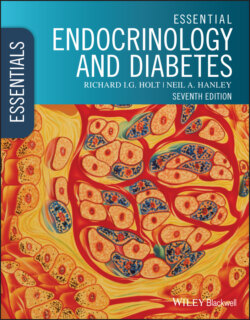Читать книгу Essential Endocrinology and Diabetes - Richard I. G. Holt - Страница 40
Post‐translational modification of peptides
ОглавлениеSome polypeptides can function as hormones after little more than removal of the starting methionine, e.g. thyrotrophin‐releasing hormone (TRH), which comprises only three amino acids. Larger peptides can fold into three‐dimensional structures, which may contain helical or pleated domains. These shapes provide stability and affect how one protein interacts with another (e.g. how a hormone might bind to its receptor).
For hormones that require secretion out of the cell, additional modifications are important (Figure 2.4). The precursor peptide, called a pre‐prohormone, carries a lipophilic signal peptide at the amino terminus. This sequence is recognized by channel proteins so that the immature peptide can cross the ER membrane. Once inside the ER, the signal peptide is excised in preparation for other post‐translational changes (Figure 2.4a–d).
Figure 2.4 Potential post‐translational modifications of peptide hormones. Four types are shown. (a) Simple changes such as removal of the amino‐terminal ‘pro‐’ extension prior to secretion (e.g. parathyroid hormone) or the addition of intra‐chain disulphide bonds (e.g. growth hormone). (b) Multiple processing of a ‘polyprotein’ into a number of different peptide hormones (e.g. pro‐opiomelanocortin can give rise to adrenocorticotrophic hormone plus melanocyte‐stimulating hormone and β‐endorphin). (c) Synthesis of insulin requires folding of the peptide and the formation of disulphide bonds. The active molecule is created by hydrolytic removal of a connecting (C)‐peptide so that proinsulin gives rise to insulin plus C‐peptide in equimolar proportion. (d) Synthesis of larger protein hormones (e.g. thyroid‐stimulating hormone, luteinizing hormone, follicle‐stimulating hormone and human chorionic gonadotrophin) from two separate peptides that complex together. The four hormones share the same α‐subunit with a hormone‐specific β‐subunit.
Disulphide bridges are formed in certain proteins (e.g. growth hormone or insulin; Figure 2.4a and c). Certain carbohydrates may be added to form glycoproteins (Figure 2.4d). Some prohormones (e.g. pro‐opiomelanocortin and pro‐glucagon) are processed into several final products, whereas others are assembled as a combination of distinct peptide chains, each synthesized from different genes, e.g. thyroid‐stimulating hormone (TSH) or luteinizing hormone (LH).
The complete protein is then packaged into membrane‐bound vesicles, which may contain specific ‘endopeptidases’. These enzymes are responsible for final hormone activation by cleaving off the ‘pro‐’ portion, as occurs with the release of insulin and its by‐product, C‐peptide (Figure 2.4c). Such post‐translational modifications are essential stages in hormone synthesis (Box 2.3).
